Pecharsky V.K., Zavalij P.Y. Fundamentals of Powder Diffraction and Structural Characterization of Materials
Подождите немного. Документ загружается.


5
12
Chapter
6
6.7
Figures of merit in full pattern decomposition
Since both Pawley and Le Bail full pattern decompositions are based on
finding a least squares solution of Eq. 6.6, the problem may be considered
solved and a pattern deconvoluted when the best possible fit between the
calculated, and observed intensities,
Y:~', is achieved. Indeed, the left
hand sides of each equation in Eq.
6.6
represent yrbS, and the right hand
sides represent
yicalc.
It is, therefore, of utmost importance to have certain numerical figures of
merit that quantify the quality of the least squares fit and therefore, may be
used to estimate the reliability of the extracted integrated 'intensities and
observed structure factors. The following figures of merit are customarily
used to characterize both the full pattern decomposition and Rietveld
refinement quality.
The profile residual (or reliability) factor, Rp:
The weighted profile residual,
R,:
The Bragg residual, RB (this figure of merit is quite important in Rietveld
refinement but has little to no use during full pattern decomposition because
only observed Bragg intensities are meaningful in both Pawley and Le Bail
methods):
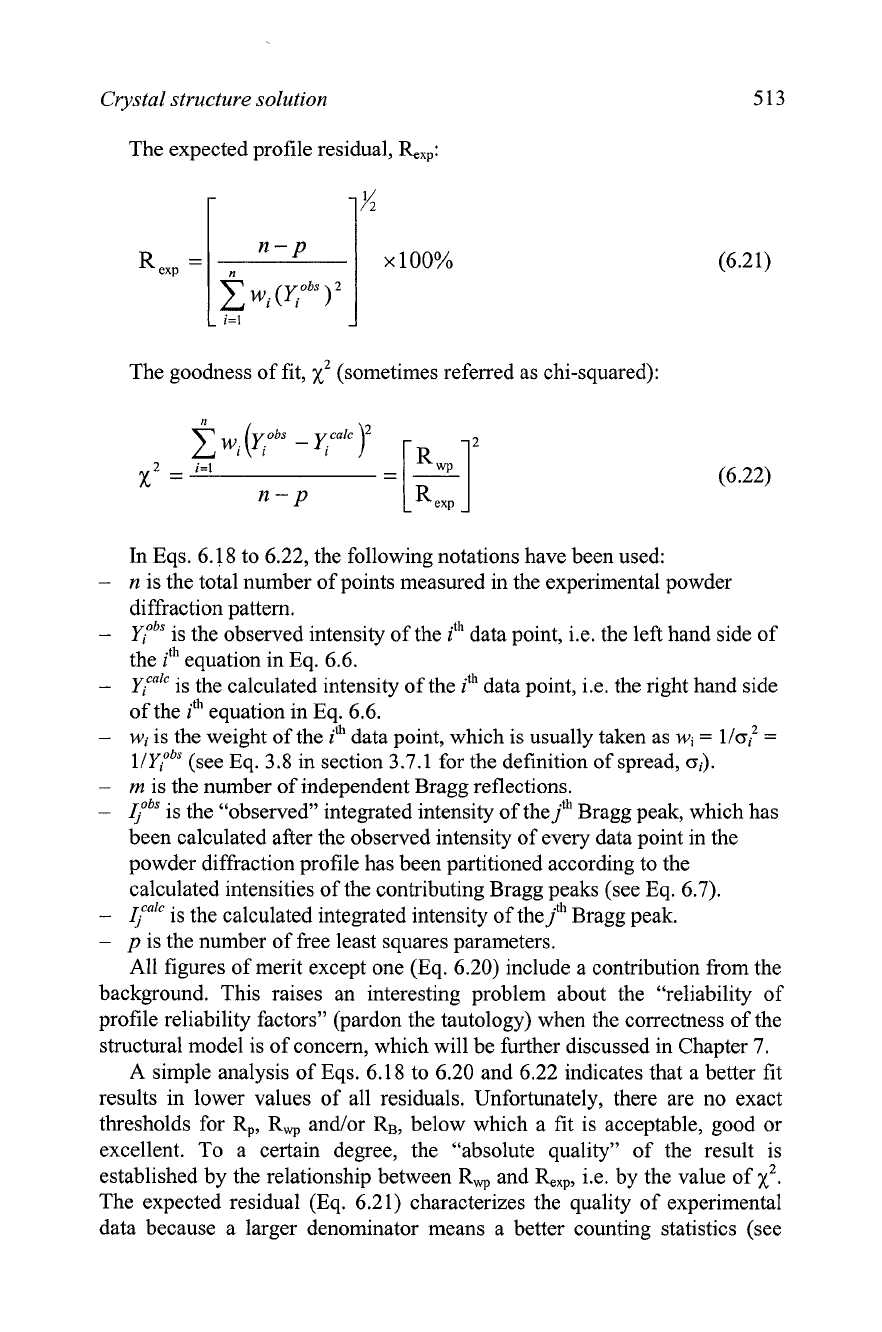
Crystal structure solution
The expected profile residual,
%,,:
The goodness of fit,
X2
(sometimes referred as chi-squared):
In
Eqs. 6.18 to 6.22, the following notations have been used:
n
is the total number of points measured in the experimental powder
diffraction pattern.
Y/'~Ys the observed intensity of the
ith
data point, i.e. the left hand side of
the
ith
equation in Eq. 6.6.
yiC"lC is the calculated intensity of the
ith
data point, i.e. the right hand side
of the
ith
equation in Eq. 6.6.
wi
is the weight of the
ith
data point, which is usually taken as
wi
=
110:
=
11~i"~"see Eq. 3.8 in section 3.7.1 for the definition of spread, oi).
rn
is the number of independent Bragg reflections.
40bYs the "observed" integrated intensity of the
jth
Bragg peak, which has
been calculated after the observed intensity of every data point in the
powder
diffraction
profile has been partitioned according to the
calculated intensities of the contributing Bragg peaks (see Eq. 6.7).
J~.""'" is the calculated integrated intensity of the
jth
Bragg peak.
p
is the number of free least squares parameters.
All figures of merit except one (Eq. 6.20) include a contribution from the
background. This raises an interesting problem about the "reliability of
profile reliability factors" (pardon the tautology) when the correctness of the
structural model is of concern, which will be further discussed in Chapter 7.
A simple analysis of Eqs. 6.18 to 6.20 and 6.22 indicates that a better fit
results in lower values of all residuals. Unfortunately, there are no exact
thresholds for Rp, R, andlor RB, below which a fit is acceptable, good or
excellent. To a certain degree, the "absolute quality" of the result is
established by the relationship between R, and kXp, i.e. by the value of
x2.
The expected residual (Eq. 6.21) characterizes the quality of experimental
data because a larger denominator means a better counting statistics (see
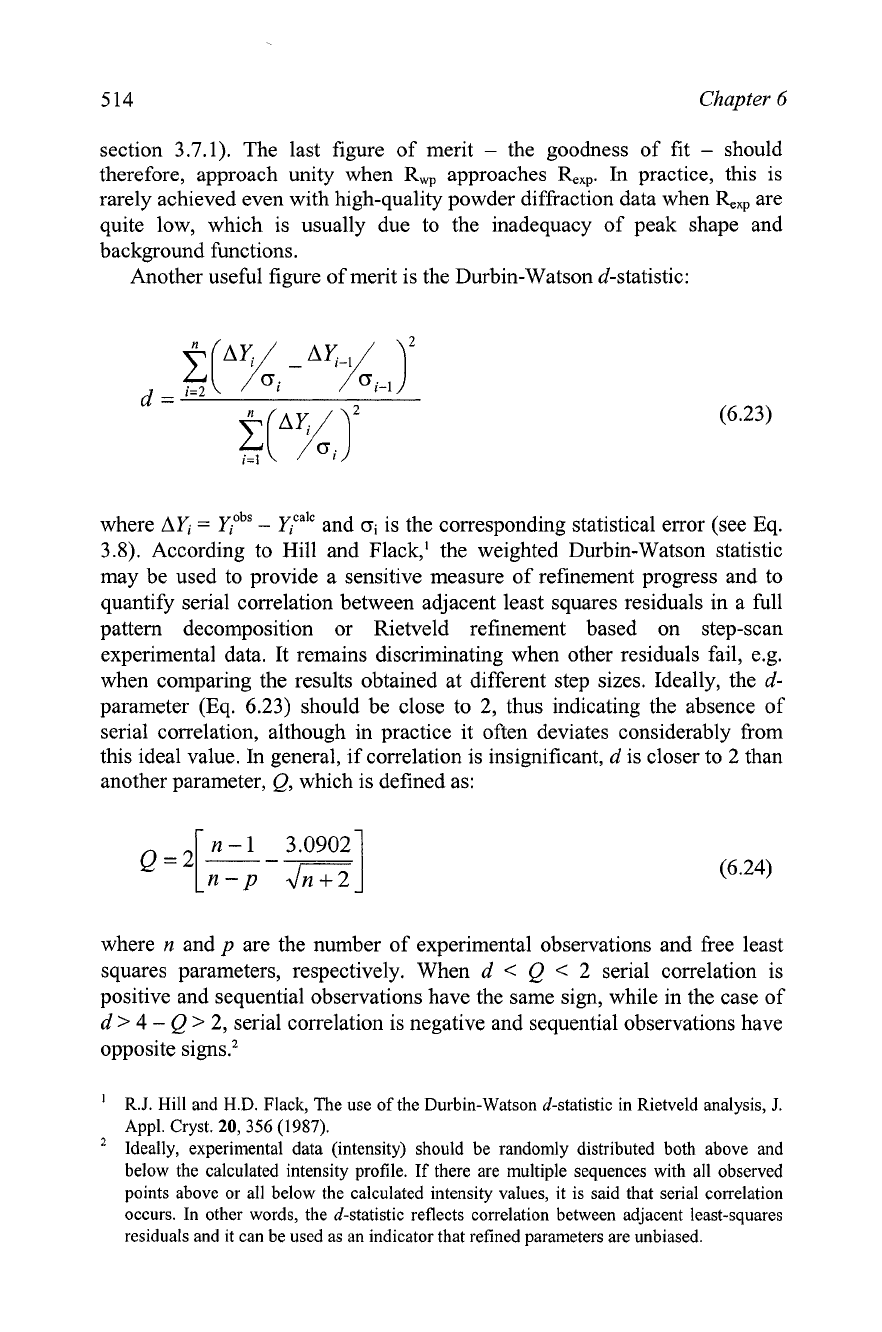
5
14
Chapter
6
section 3.7.1). The last figure of merit
-
the goodness of fit
-
should
therefore, approach unity when
R,
approaches
&,,.
In
practice, this is
rarely achieved even with high-quality powder diffraction data when
%,
are
quite low, which is usually due to the inadequacy of peak shape and
background functions.
Another useful figure of merit is the Durbin-Watson d-statistic:
where
A&
=
yiObS
-
yiCalc
and
oi
is the corresponding statistical error (see Eq.
3.8).
According to Hill and Flack,' the weighted Durbin-Watson statistic
may be used to provide a sensitive measure of refinement progress and to
quantify serial correlation between adjacent least squares residuals in a full
pattern decomposition or Rietveld refinement based on step-scan
experimental data. It remains discriminating when other residuals fail,
e.g.
when comparing the results obtained at different step sizes. Ideally, the d-
parameter (Eq. 6.23) should be close to 2, thus indicating the absence of
serial correlation, although in practice it often deviates considerably
from
this ideal value.
In
general, if correlation is insignificant, d is closer to 2 than
another parameter,
Q,
which is defined as:
where
n
and
p
are the number of experimental observations and free least
squares parameters, respectively. When
d
<
Q
<
2 serial correlation is
positive and sequential observations have the same sign, while in the case of
d
>
4
-
Q
>
2,
serial correlation is negative and sequential observations have
opposite signs.2
R.J. Hill and H.D. Flack, The use of the Durbin-Watson d-statistic in Rietveld analysis,
J.
Appl. Cryst.
20,
356
(1987).
Ideally, experimental data (intensity) should be randomly distributed both above and
below the calculated intensity profile.
If
there are multiple sequences with all observed
points above or all below the calculated intensity values, it is said that serial correlation
occurs.
In
other words, the d-statistic reflects correlation between adjacent least-squares
residuals and it can be used as an indicator that refined parameters are unbiased.
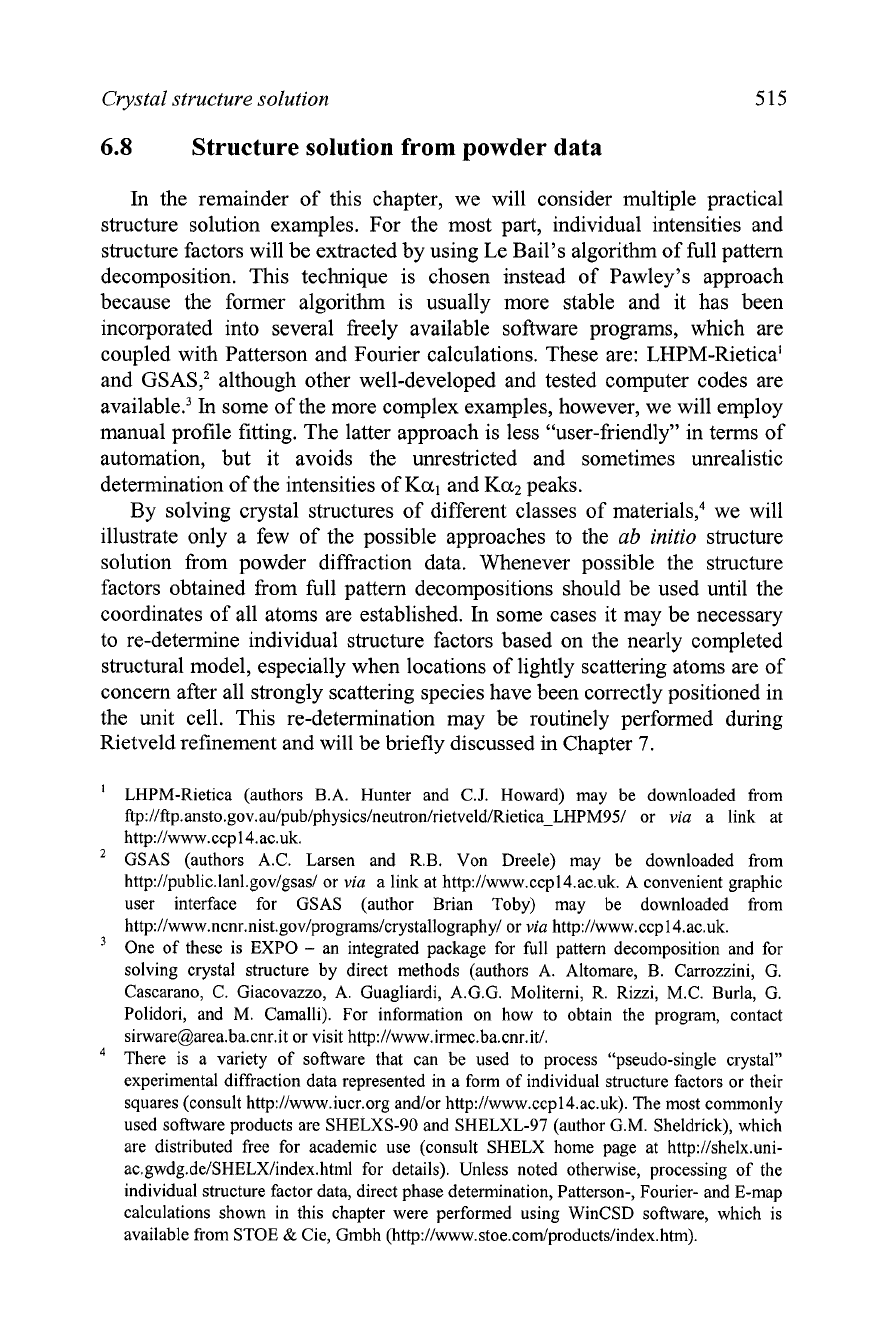
Crystal structure solution
515
6.8
Structure solution from powder data
In the remainder of this chapter, we will consider multiple practical
structure solution examples. For the most part, individual intensities and
structure factors will be extracted by using Le Bail's algorithm of full pattern
decomposition. This technique is chosen instead of
Pawley's approach
because the former algorithm is usually more stable and it has been
incorporated into several freely available software programs, which are
coupled with Patterson and Fourier calculations. These are: LHPM-Rietical
and GSAS,' although other well-developed and tested computer codes are
a~ailable.~
In
some of the more complex examples, however, we will employ
manual profile fitting. The latter approach is less "user-friendly" in terms of
automation, but it avoids the unrestricted and sometimes unrealistic
determination of the intensities of
Ka,
and
Ka2
peaks.
By solving crystal structures of different classes of
material^,^
we will
illustrate only a few of the possible approaches to the
ab initio
structure
solution from powder diffraction data. Whenever possible the structure
factors obtained from full pattern decompositions should be used until the
coordinates of all atoms are established.
In
some cases it may be necessary
to re-determine individual structure factors based on the nearly completed
structural model, especially when locations of lightly scattering atoms are of
concern after all strongly scattering species have been correctly positioned in
the unit cell. This re-determination may be routinely performed during
Rietveld refinement and
will
be briefly discussed in Chapter
7.
LHPM-Rietica (authors B.A. Hunter and C.J. Howard) may be downloaded from
ftp:Nftp.ansto.gov.au/pub/physics/neutron/rietveld/RieticaLHPM95/
or
via
a link at
http://www.ccp14.ac.uk.
GSAS (authors A.C. Larsen and R.B. Von Dreele) may be downloaded from
http://public.lanl.gov/gsas/
or
via
a link at http://www.ccpl4.ac.uk. A convenient graphic
user interface for GSAS (author Brian Toby) may be downloaded from
http://www.ncnr.nist.gov/programs/crystallography/
or
via
http://www.ccpl4.ac.uk.
One of these is EXPO
-
an integrated package for full pattern decomposition and for
solving crystal structure by direct methods (authors
A.
Altomare, B. Carrozzini, G.
Cascarano, C. Giacovazzo, A. Guagliardi, A.G.G. Moliterni, R. Rizzi, M.C. Burla, G.
Polidori, and M. Camalli). For information on how to obtain the program, contact
sirware@area.ba.cnr.it or visit
http://www.irmec.ba.cnr.it/.
There is a variety of software that can be used to process "pseudo-single crystal"
experimental diffraction data represented in a form of individual structure factors or their
squares (consult http://www.iucr.org and/or
http://www.ccpl4.ac.uk).
The most commonly
used software products are SHELXS-90 and SHELXL-97 (author G.M. Sheldrick), which
are distributed free for academic use (consult SHELX home page at
http://shelx.uni-
ac.gwdg.de/SHELX/index.html
for details). Unless noted otherwise, processing of the
individual structure factor data, direct phase determination, Patterson-, Fourier- and E-map
calculations shown in this chapter were performed using WinCSD software, which is
available from STOE
&
Cie, Gmbh
(http://www.stoe.com/products/index.htm).

5 16 Chapter
6
6.9
Crystal structure
of
LaNi4.85Sn0.151
Consider a powder diffraction pattern of LaNi4.85Sno.ls, which is shown in
Figure
6.4.
Files Ch6ExOl-CuKa.dat and Ch6ExOl'-CuKa.xy, which
contain the same experimental data saved in two different formats, are found
on the CD accompanying this book. From Chapter 5 we already known that
the alloy is hexagonal and the lattice parameters are a
=
5.0421, c
=
4.0 1 18 A.
Analysis of Table
5.6
indicates that there are no forbidden
reflections, and from Table
2.14
and Table
2.15
the possible space group
symmetries for this material are as follows: P6/mmm, ~6m2, ~62m, P6mm,
P622, P6/m, ~6, P6, ~51m, P31m, P312, ~?;ml, P3m1, P321, ~5, and P3.
The fact that a total of 16
(!)
space groups are possible for this material
could make it a complicated choice for the ab
initio
structure solution.
However, its unit cell is quite small. Furthermore, LaNi4.s5Sno.ls is an
intermetallic compound and therefore, the highest symmetry space group
(P61mmm) is quite probable.
The measured gravimetric density of the alloy is 8.21 g/cm3. After
calculating the mass of its formula unit,
M
=
441.4 a.m.u., and the unit cell
volume,
V
=
d3a2c/2
=
88.327 A3,
Eq.
6.4 results in
Z
=
0.99
=
1. Thus, one
unit cell of the compound contains 1 La, 4.85 Ni and 0.15 Sn atoms. Because
of the fractional amounts in the unit cell, the Ni and Sn atoms are likely
distributed statistically in their respective crystallographic sites (they have
similar atomic radii:
r~i
=
1.35, rs,
=
1.45
A),
but much larger La atoms (rL,
=
1.95
A)
should occupy a separate crystallographic site. Thus, before
proceeding with the full pattern decomposition it is advisable to check
whether some of the space groups that are possible for this compound can be
eliminated.2 Analysis of the multiplicities of site positions of the 16 possible
space groups indicates that none of the groups can be excluded outright
because every space group symmetry has I-, 2- and 3-fold sites (some of the
trigonal space groups have only 1- and 3-fold sites), which are sufficient to
accommodate one La and a total of five Ni+Sn atoms.
'
J.
Ting,
I.E.
Anderson, and
V.K.
Pecharsky, unpublished.
Generally, it is unnecessary to have the exact space group symmetry information during
the full pattern decomposition. In fact, it is more practical to select the most symmetrical
space group in the established diffraction group and avoid multiple and complete Bragg
peak overlaps. For example when both trigonal and hexagonal symmetry (primitive lattice)
groups are possible, full pattern decomposition is best performed in the hexagonal crystal
system assuming Laue class
Glmrnm. This eliminates Bragg doublets (e.g.
hkl
and
khl,
which are present in the Laue class Glm) and quadruplets (e.g.
hkl, hk
7;
khl
and
kh
7;
which
should be taken into account in the Laue class
3),
which are indistinguishable using both
Le Bail and Pawley techniques. For structure solution, it may be necessary to add the
missing combinations of indices to the array of structure amplitudes obtained in the
highest symmetry space group.

Crystal structure solution
517
20
40
60
80 100 120
Bragg angle,
20
(deg.)
Figure
6.4.
The powder diffraction pattern collected from a sample of LaNi,,8SSno,Is using
Cu Ka radiation on a Rigaku
TTRAX
rotating anode diffractometer. The divergence slit was
0.75' and the receiving slit was 0.03O. The experiment was carried out in a continuous
scanning mode with a rate 0.5
deglmin and with a sampling step 0.02'. The powder used in
this experiment was prepared by gas atomization from the melt and therefore, particles were
nearly spherical (see inset in
Figure
3.32).
In
this example,' we will use LHPM-Rietica. For readers that have no
experience with the program, we suggest using both the manual, which is
available for download with the software, and a Web-based tutorial2 in
combination with the experimental data found on the
CD.
Ideally, the results
presented below should be reproduced nearly exactly, although small
deviations may occur due to the nature of the non-linear least squares.
Full pattern decomposition usually begins with the refinement of the
background while keeping peak shape and instrumental parameters fixed at
their default values, and unit cell dimensions fixed at their best-known
values. We begin with only two parameters representing the background as a
'
Due to its simplicity, this example is purely academic, however, it is an excellent sample
to gain initial experience in deconvoluting powder diffraction patterns using Le Bail's
technique. Therefore, it will be considered in detail.
Brett Hunter, LHPM-Rietica Rietveld for Win951NT. Tutorial is accessible
via
http://www.ccpl4.ac.uk/,
then "Tutorials" on the site map, then "LHPM-
Rietica-Rietveld".
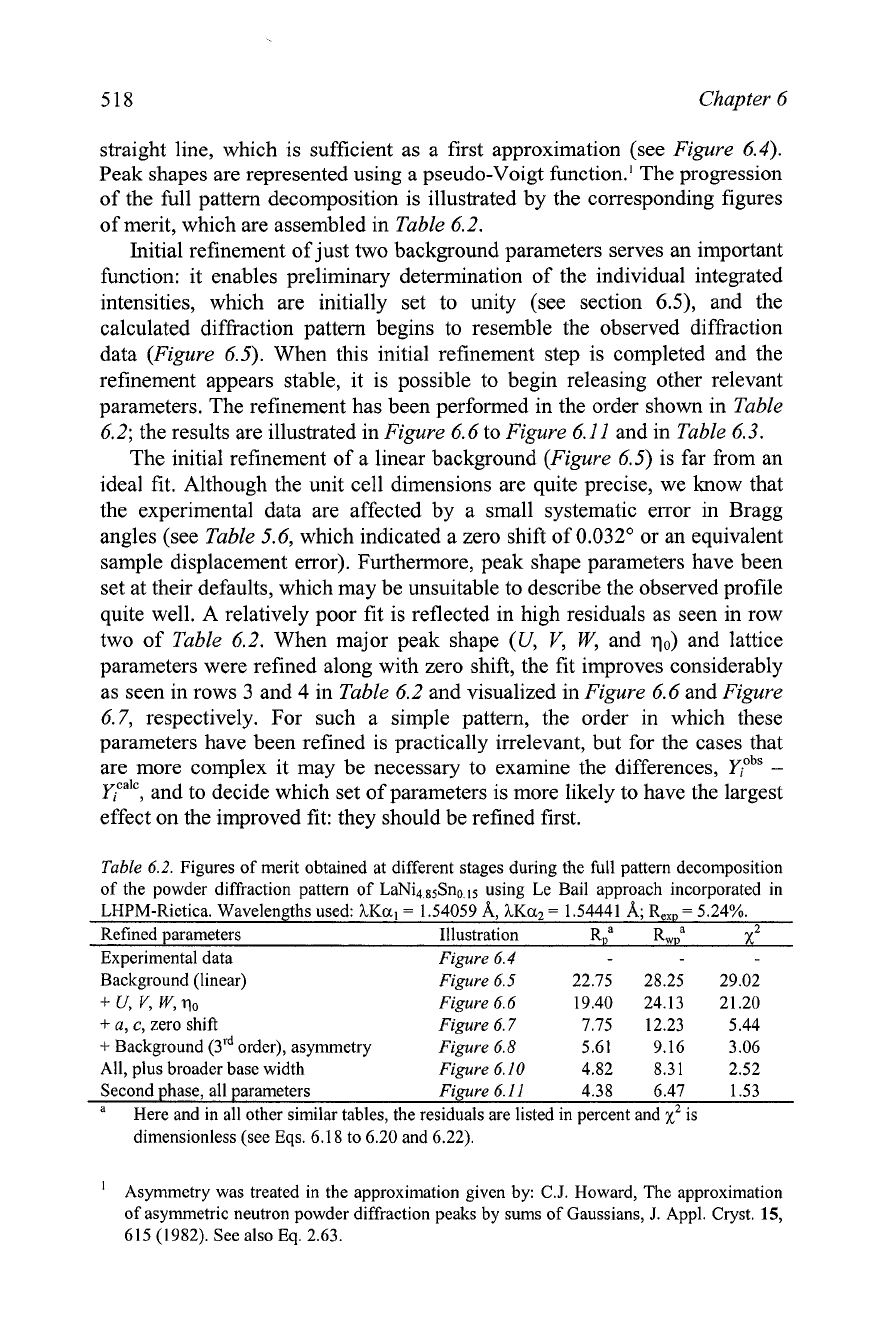
Chapter 6
straight line, which is sufficient as a first approximation (see Figure
6.4).
Peak shapes are represented using a pseudo-Voigt function.' The progression
of the full pattern decomposition is illustrated by the corresponding figures
of merit, which are assembled in Table 6.2.
Initial refinement of just two background parameters serves an important
function: it enables preliminary determination of the individual integrated
intensities, which are initially set to unity (see section
6.5),
and the
calculated diffraction pattern begins to resemble the observed diffraction
data (Figure 6.5). When this initial refinement step is completed and the
refinement appears stable, it is possible to begin releasing other relevant
parameters. The refinement has been performed in the order shown in Table
6.2; the results are illustrated in Figure 6.6 to Figure 6.11 and in Table 6.3.
The initial refinement of a linear background (Figure 6.5) is far from an
ideal fit. Although the unit cell dimensions are quite precise, we know that
the experimental data are affected by a small systematic error in Bragg
angles (see Table 5.6, which indicated a zero shift of
0.032' or an equivalent
sample displacement error). Furthermore, peak shape parameters have been
set at their defaults, which may be unsuitable to describe the observed profile
quite well. A relatively poor fit is reflected in high residuals as seen in row
two of Table 6.2. When major peak shape
(U,
V,
W,
and
qo)
and lattice
parameters were refined along with zero shift, the fit improves considerably
as seen in rows 3 and
4
in Table 6.2 and visualized in Figure 6.6 and Figure
6.7, respectively. For such a simple pattern, the order in which these
parameters have been refined is practically irrelevant, but for the cases that
are more complex it may be necessary to examine the differences,
Zalc,
and to decide which set of parameters is more likely to have the largest
effect on the improved fit: they should be refined first.
Table 6.2.
Figures of merit obtained at different stages during the full pattern decomposition
of the powder diffraction pattern of LaNi4,85Sno.ls using Le Bail approach incorporated in
LHPM-Rietica. Wavelengths used:
hKa,
=
1
S4O59
A,
hKaz
=
1 S4441
A;
Re,,
=
5.24%.
Refined parameters Illustration
R;
Rw;
2
Experimental data
Figure
6.4
Background (linear)
Figure 6.5
22.75 28.25 29.02
+
u,
v,
w,
TO
Figure 6.6
19.40 24.13 21.20
+
a,
c,
zero shift
Figure
6.7
7.75 12.23 5.44
+
Background (3'd order), asymmetry
Figure 6.8
5.61 9.16 3.06
All, plus broader base width
Fiwre 6.10
4.82 8.31 2.52
second ~hase. all ~arameters
~Lre 6.11
4.38 6.47 1.53
a
Here and in all other similar tables, the residuals are listed in percent and
X2
is
dimensionless (see Eqs. 6.18 to 6.20 and 6.22).
'
Asymmetry was treated in the approximation given
by:
C.J. Howard, The approximation
of asymmetric neutron powder diffraction peaks by sums of Gaussians,
J.
Appl. Cryst.
15,
615 (1982). See also Eq. 2.63.

Crystal structure solution
519
8
LaNi
,,,,
Sn
,,,,,
Cu
Ka
20 40 60 80 100 120
Bragg angle,
28
(deg.)
Figure
6.5.
The observed (circles) and calculated (lines) powder patterns of LaNi4.s5Sno,15
after a linear background has been refined. Peak shape parameters were kept at their default
values and lattice parameters were fixed at
a
=
5.0421,
c
=
4.01 18
A.
The vertical bars located
just below the background level indicate calculated positions of Bragg peaks for
h
Ka,.
The
curve in the bottom part of the plot represents the difference
qobS
-
Y,Ca''.
me scales for the
observed, calculated and difference plots are identical. The inset clarifies details in the
vicinity of the strongest Bragg peak. Same notations are maintained in all similar figures
below and throughout the book.
In
this example, lattice parameters and the zero shift correction have a
substantial impact on the quality of the fit and the weighted profile residual,
R,,
decreases nearly two-fold (from
-24
to
-12
%),
while the refinement of
peak shape parameters decreases
R,
by only
-4
%.
Therefore, in this case
lattice parameters should have been refined first. However, it is not always
obvious which parameters are more important and should be released at a
particular stage of the least squares refinement. Because of this, in complex
cases a trial-and-error approach is often employed.'
'
A
specific of the Le Bail's approach nearly always requires that early refinement includes
the simplest suitable background function with all other relevant parameters kept fixed at
their default or approximately known values. This ensures the proper determination of the
individual integrated intensities, which are initially set to identical values, and the overall
success of the full pattern decomposition.

5
20
Chapter
6
8
LaNi
,,,,
Sn
,,,,,
Cu
Ka
20 40 60 80 100 120
Bragg angle,
28
(deg.)
Figure
6.6.
The observed and calculated powder diffraction patterns of LaNi4,85Sno.ls after
peak shape parameters,
U,
V,
Wand qo, were refined together with linear background.
Bragg angle,
28
(deg.)
Figure
6.7.
The observed and calculated powder diffraction patterns of LaNi4,85Sno
IS
after
zero shift and lattice parameters were included in the refinement.
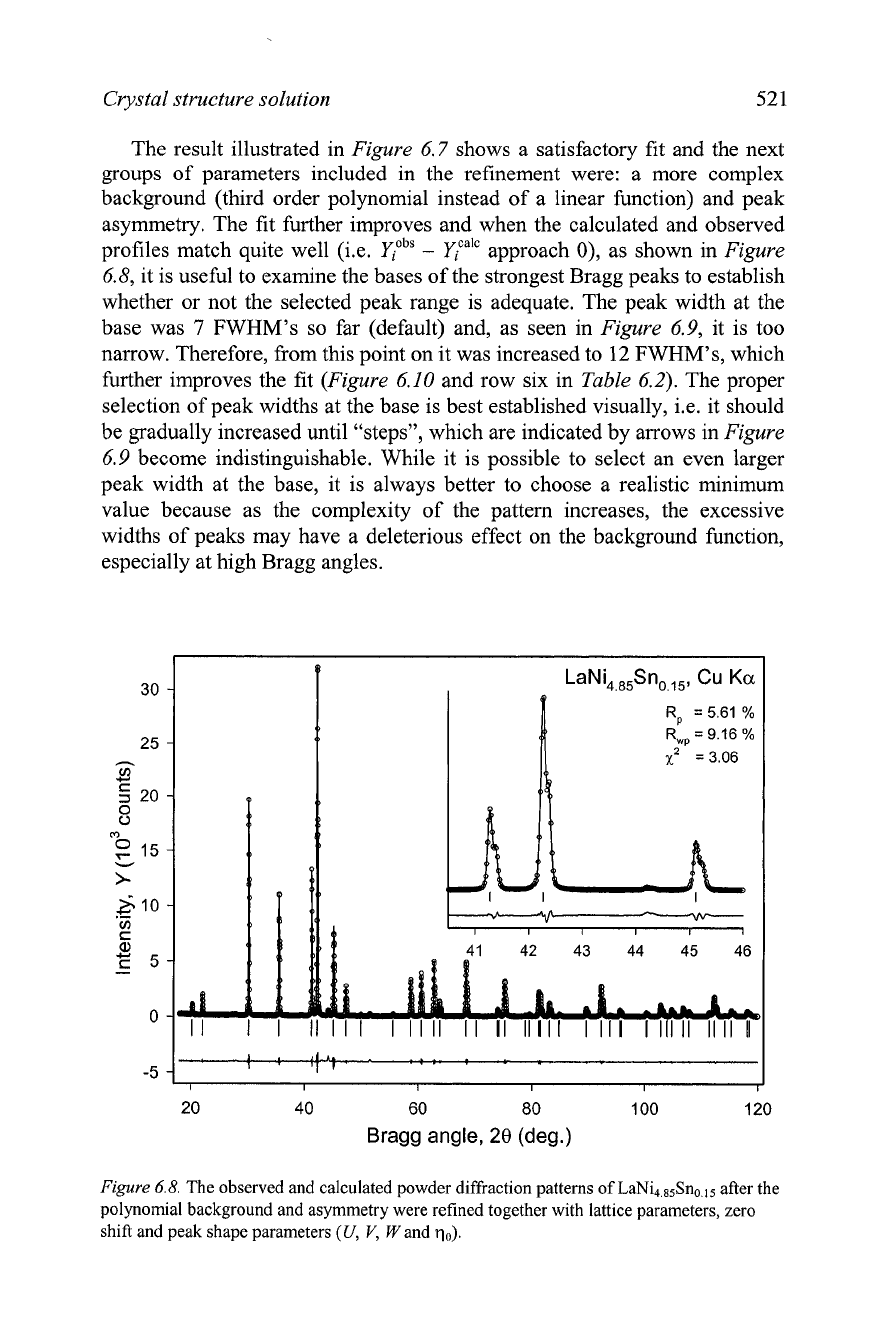
Crystal structure solution
52
1
The result illustrated in Figure 6.7 shows a satisfactory fit and the next
groups of parameters included in the refinement were: a more complex
background (third order polynomial instead of a linear function) and peak
asymmetry. The fit further improves and when the calculated and observed
profiles match quite well
(i.e.
Y?"
-
Y?"
approach
0),
as shown in Figure
6.8, it is useful to examine the bases of the strongest Bragg peaks to establish
whether or not the selected peak range is adequate. The peak width at the
base was
7
FWHM's so far (default) and, as seen in Figure 6.9, it is too
narrow. Therefore, from this point on it was increased to
12
FWHM's, which
further improves the fit (Figure
6.10
and row six in Table
6.2).
The proper
selection of peak widths at the base is best established visually, i.e. it should
be gradually increased until "steps", which are indicated by arrows in Figure
6.9 become indistinguishable. While it is possible to select an even larger
peak width at the base, it is always better to choose a realistic minimum
value because as the complexity of the pattern increases, the excessive
widths of peaks may have a deleterious effect on the background function,
especially at high Bragg angles.
LaNi,,,,Sn,,,,,
Cu
Ka
R,,
=
9.16
%
41
42
43
44
45
46
20 40 60 80 100 120
Bragg angle,
28
(deg.)
Figure
6.8.
The observed and calculated powder diffraction patterns of LaNi4,85Sno.15 after the
polynomial background and asymmetry were refined together with lattice parameters, zero
shift and peak shape parameters
(U, V,
Wand qo).
